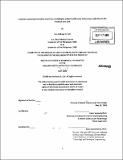Localized customized mortality prediction modeling for patients with acute kidney injury admitted to the intensive care unit
Author(s)
Celi, Leo Anthony G
DownloadFull printable version (9.042Mb)
Alternative title
Local customized mortality for patients with acute kidney injury admitted to the intensive care unit
Other Contributors
Harvard University--MIT Division of Health Sciences and Technology.
Advisor
Peter Szolovits.
Terms of use
Metadata
Show full item recordAbstract
Introduction. Models for mortality prediction are traditionally developed from prospective multi-center observational studies involving a heterogeneous group of patients to optimize external validity. We hypothesize that local customized modeling using retrospective data from a homogeneous subset of patients will provide a more accurate prediction than this standard approach. We tested this hypothesis on patients admitted to the ICU with acute kidney injury (AKI), and evaluated variables from the first 72 hours of admission. Methods. The Multi-parameter Intelligent Monitoring for Intensive Care II (MIMIC II) is a database of patients admitted to the Beth Israel Deaconess Medical Center ICU. Using the MIMIC II database, we identified patients who developed acute kidney injury and who survived at least 72 hours in the ICU. 118 variables were extracted from each patient. Second and third level customization of the Simplified Organ Failure Score (SAPS) was performed using logistic regression analysis and the best fitted models were compared in terms of Area under the Receiver Operating Characteristic Curve (AUC) and Hosmer-Lemeshow Goodness-of-Fit test (HL). The patient cohort was divided into a training and test data with a 70:30 split. Ten-fold cross-validation was performed on the training set for every combination of variables that were evaluated. The best fitted model from the cross-validation was then evaluated using the test set, and the AUC and the HL p value on the test set were reported. Results. A total of 1400 patients were included in the study. Of these, 970 survived and 430 died in the hospital (30.7% mortality). We observed progressive improvement in the performance of SAPS on this subset of patients (AUC=0.6419, HL p=0) with second level (AUC=0.6639, HL p=0.2056), and third level (AUC=0.7419, HL p=0.6738) customization. The best fitted model incorporated variables from the first 3 days of ICU admission. The variables that were most predictive of hospital mortality in the multivariate analysis are the maximum blood urea nitrogen and the minimum systolic blood pressure from the third day. Conclusion. A logistic regression model built using local data for patients with AKI performed better than SAPS, the current standard mortality prediction scoring system.
Description
Thesis (S.M.)--Harvard-MIT Division of Health Sciences and Technology, 2009. Cataloged from PDF version of thesis. Includes bibliographical references (p. 33-35).
Date issued
2009Department
Harvard University--MIT Division of Health Sciences and TechnologyPublisher
Massachusetts Institute of Technology
Keywords
Harvard University--MIT Division of Health Sciences and Technology.